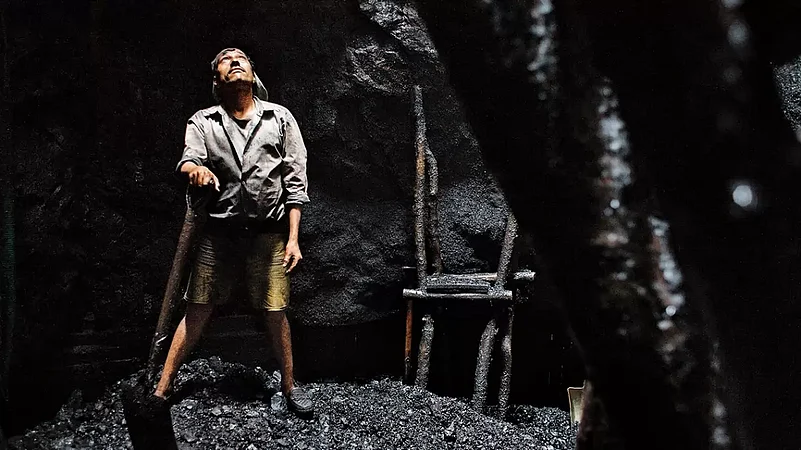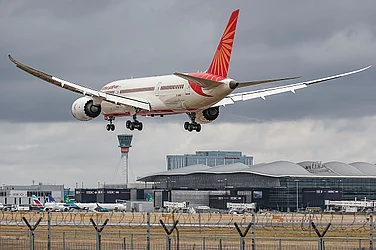Tuber Kmaishnong—a small, hilly village 25 km from the district headquarters of Jowai in the East Jaintia Hills in Meghalaya—goes silent as soon as the sun sets. There is very little hustle and bustle in the market where one would usually find Nepalis selling tea and vendors, mostly belonging to the Pnar tribe, selling vegetables. The village is deserted and the arrival of an unknown vehicle does not go unnoticed. Villagers are conscious of ‘outsiders’. They are particularly wary of anyone who carries a camera, does not look like them, or cannot speak Pnar, their language. This alertness comes with a reason. This is one of the many villages in the East Jaintia Hills where the primary source of income is through the illegal method of rat-hole mining—a primitive way of extracting coal by digging deep tunnels.
When Outlook’s team reached the village, a shopkeeper warned us saying: “This is the same village market where four years ago, two women, trying to take photographs of coal mining, were assaulted.” He was referring to the assault on two Meghalaya-based anti-coal mining activists in November 2018. He asked us not to discuss coal mining with the locals and to “rush out of the village as soon as possible”.
The upcoming Assembly election is crucial for hundreds of villages in Meghalaya that fall in the coal belt. Thousands of people in the East Jaintia Hills, West Khasi Hills and West Jaintia Hills in the coal-rich state were dependent on the coal mining deposits found along the Southern fringe of the Shillong plateau, extending over a length of 400 km. All was well until the National Green Tribunal (NGT) banned rat-hole mining in 2014.
It has become a major political issue in the region and in the upcoming Assembly elections people may prefer to vote for a party that promises to relax the nine-year-old impasse on rat-hole mining.
A few years after the 2014 ban, in the 2018 Assembly elections, the ruling Congress, which used to enjoy a majority of seven seats in the region, of the 60-member Meghalaya Assembly, bore the brunt. The National People’s Party (NPP) and the BJP used the issue to their advantage and promised to relax the ban within six months of coming to power. Comrad Sangma-led NPP managed to bag three seats, while the Congress, which had won three seats in the 2013 elections, was reduced to one in 2018. The United Democratic Party (UDP), another regional party, won the remaining three seats.
While rat-hole mining is still practised and discussed discreetly in these parts, the issue is gradually getting louder with the approaching Assembly elections. Presently, it is one of the most discussed issues in the Khasi and Jaintia Hills of Meghalaya with various political leaders campaigning in rural areas promising to lift the ban.
The NGT had banned rat-hole mining citing the Right to Life and its hazardous impact on the environment. However, fatal accidents in the mining fields in Meghalaya from time to time have proved that illegal mining was going on in many areas, despite the ban. The NPP-led Meghalaya government was slapped with a fine of Rs 100 crore in 2019 for failing to stop rat-hole mining, even five years after the imposition of the ban.
“We have been living on coal for ages. We don’t have agricultural land. Whoever had land, coal mining polluted them and made them unfit for agriculture. We want the government to do something to convince the Centre to lift the ban. So, yes, we want our representatives to take this issue up with the Centre at the earliest,” says a villager from the Tuber Kmaishnong village on the condition of anonymity.
In 2019, the Supreme Court set aside the NGT ban and allowed coal mining in the state through scientific mining methods. It said that coal mining should be done under the Mines and Minerals (Development and Regulation) Act (MMDR) and the Mineral Concession Rules, 1960. The Meghalaya Democratic Alliance (MDA) government, led by the NPP and supported by the BJP, took full credit for the SC order. However, it irked small-time coal miners as mining under the MMDR Act is a tedious process with lots of red-tape involved.
After the SC order, the Meghalaya government issued a Standard Operating Procedure (SoP) for granting a Prospecting Licences and Mining Leases for coal, which involves a complex bureaucratic process of obtaining valid land documents, a map of the proposed mining site, a non-forest area declaration, a certificate of the Sixth Schedule status, and an agreement between the applicant of coal mining and landowners, among others. It also has a clause, which says that the proposed area for mining should not be less than 100 hectares.
“No one in our area holds 100 hectares of land. So, where will we go and apply for licences? We mine in small areas as the coal is scattered around,” says another villager.
Many have also alleged that the order has benefitted big businesses and politicians, who own coal fields or can manage to procure mining licences easily. It’s the small-scale miners who are adversely affected.
In January, five pressure groups—The Hynniewtrep Youth Council (HYC), the East Jaintia National Council (EJNC), the Jaintia Students’ Movement (JSM), the Hynniewtrep A’chik National Movement (HANM) and the Confederation of Ri-Bhoi People (CoRP)—met incumbent chief minister and leader of the NPP and requested that the clause which says the proposed area for mining should not be less than 100 hectares be removed from the SoP.
Talking to Outlook, Sumi Bareh, the Trinamool Congress candidate from 6 Khliehriat constituency of the East Jaintia Hills, says: “Coal mining is a huge issue here and villagers are angered by the fact that there is still a ban on traditional methods of mining, without providing them with another source of livelihood. So, in these polls, people are looking to vote for a government that would make mining easy. Because, even if illegal mining is going on, the business has fallen by almost 90-95 per cent.”
Even though Conrad Sangma took credit for the SC order which allowed coal mining under the MMDR Act, this time the voters are looking for an alternative to the NPP; someone who can legalise rat-hole mining.
“The mining issue is the biggest economic issue in this election. The NPP-led alliance failed to keep their promises. People are in great distress. We urgently need to find a way for scientific mining that would get the NGT’s approval. Till then, we have to focus on alternative sources of income generation. We can’t keep continuing with the practice of looking the other way when people are forced to indulge in illegal practices out of desperation,” says Justine G. Momin, TMC candidate from Mawshynrut in the West Khasi Hills district.
According to George Clarence Nongbet, BJP General Secretary of Meghalaya, coal mining is a serious election issue, especially in the Jaintia Hills. He claims that people, more than anything else, are interested in who can lift the ban on rat-hole mining.
Talking to Outlook, he says that lifting the ban was a poll promise made by the NPP but it could not do much about it. “Illegal coal mining is going on and so is illegal transportation. The coal is transported from here, but the mafias use challans (licenses) of other states, like Assam, to cover it. Lifting the ban will be a promise in our election manifesto. The villagers are still mining clandestinely. But they would ideally vote for a party that can lift the ban as they cannot mine freely anymore,” says Nongbet. He adds that legalising coal mining in the state would be a promise in the party’s manifesto of the BJP.
Another party, the United Democratic Party (UDP), one of the oldest tribal parties led by Metbah Lyngdoh, opts for a middle path. Lyngdoh says any party that comes to power should work in the favour of a mining method, which is friendly to the people as well as the environment.
“As far as mining is concerned, it is the need of the hour to take a serious call on the issue as it is affecting livelihoods. Now, the SC has relaxed it to some extent with a mining policy but the government has a big role to play in helping people mine,” he says.
In Meghalaya’s political scenario, a new trend is emerging—the participation of anti-coal activists as political candidates. Under the leadership of anti-coal mine and rights activist Angela Rangad, KAM Meghalaya, a political platform, has fielded three candidates in the upcoming Assembly polls.
Rangad is contesting from 19 South Shillong constituency against three-time BJP MLA Sanbor Shullai. Rangad, also a leader of the Thma U Rangli Juki (TUR), an organisation that has been vocal about illegal coal mining in the state, has criticised political parties for promising coal mining to voters. Talking to Outlook, Rangad says: “Last time, the BJP-backed NPP promised that they would allow coal mining after coming to power. These promises were made by people who indulge in impunity. The NGT and the Supreme Court have very clearly said that you have to follow the MMDR Act, Mines Act, etc to mine. Even now, there is a ban and yet illegal transportation is going on. Most of the legislators themselves are coal mine owners. So, that is their interest in capturing political power.”
(This appeared in the print edition as "In a Mining Rathole")


























